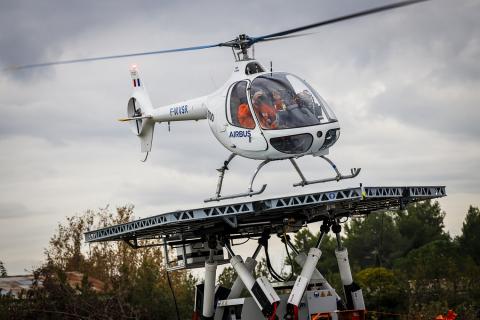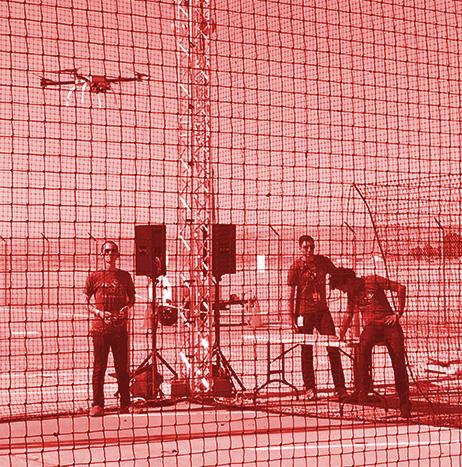There are more than 1,400 species of bats, and bats make up about 25% of all mammals. In North America, bats contribute about $23 billion in pest control services to the agricultural industry. Around the world, bats are crucial for pollination and seed dispersal and consume insects that transmit diseases. But, bats are under threat from habitat destruction and other human activities.
Bats aren’t actually blind, they have extremely sensitive eyes that allow them to see in the dark. But to navigate and hunt, most bats use sound. Known as echolocation, bats listen to the echoes of their ultrasonic calls bouncing off their prey—fishing bats have echolocation so sophisticated they can detect the fin of a minnow protruding only two millimeters above the water’s surface.
Swarming
Swarming
MBZIRC Maritime Grand Challenge Provides Opportunity For Unmanned Systems Competition, Collaboration, Innovation
The Mohammed Bin Zayed International Robotics Challenge (MBZIRC) is a global competition designed to push the boundaries of autonomous robotics. With a total prize purse of over US $3 million, the challenge is held every two years in Abu Dhabi, UAE, and provides universities, research centers, companies, and individual innovators an opportunity to address global challenges through the development of autonomous robotic technology.

Sonardyne Technology Selected to Support Fugro's Fleet of Uncrewed Surface Vessels
Technology from Sonardyne has been chosen to support leading geo-data specialist Fugro’s global fleet of uncrewed surface vessels (USVs) and remotely-operated vehicles (ROVs).
Sonardyne’s Mini-Ranger 2 Ultra-Short BaseLine (USBL) position system will be integrated into Fugro’s new 12-meter long Blue Essence USV, the first of which will be delivered to Fugro’s base in Perth in February. Once integrated, the Mini-Ranger 2 will allow the Blue Essence to deploy, track, command and control ROVs and underwater autonomous vessels (UAVs) as part of inspection, survey and data harvesting projects - all of which will be controlled from Fugro’s onshore remote operations centers.

Weekend Roundup: December 4, 2020
This week (and last) in the Unmanned Systems and Robotics World
Mississippi State University (MSU) engineers in the university’s Raspet Flight Research Laboratory are leading research efforts that could make UAS operational by the U.S. government, as well as civilian aviation, in icy conditions. The U.S. Department of Defense is hoping that the icing system development and technology team being led by MSU will result in lightweight anti-icing systems, which would lead to certification for UAS to operate in forecasted icing conditions. (Mississippi State University)

Weekend Roundup: November 13, 2020
This Week in the Unmanned Systems and Robotics World
Scientific Systems Company Inc. (SSCI) has demonstrated a team made up of a fully autonomous UAS and a search and rescue canine working together without intervention from a human handler to conduct a simulated search and rescue mission. During the demonstration, SSCI's newly developed Teammate Aware Autonomy (TAA) system was used together with its Collaborative Mission Autonomy (CMA) and Finding Objects thru Closed Loop Understanding of the Scene (FOCUS) software. (PRNewswire)

Blue Bear Systems' 20-drone swarm conducts BVLOS operations
Blue Bear Systems recently operated 20 fixed wing drones to form a collaborative heterogeneous swarm that conducted beyond visual line of sight (BVLOS) operations.
The heterogeneous swarm built off of a 12-drone swarm that Blue Bear demonstrated in July. The latest heterogeneous swarm was made up of five different types and sizes of fixed wing Blue Bear drones, including Vertical Take Off and Landing (VTOL) fixed wing Ghost/Modular Ghost UAS, conventional fixed wing Red Kite UAS, conventional fixed wing Cobra UAS and smaller hand launched Flat Pack UAS.

Weekend Roundup: June 19, 2020
This Week in the Unmanned Systems and Robotics World
A proof of concept experiment by a multi-institutional research team shows that deploying sterile mosquitoes via drones could accelerate efforts to control their populations and reduce insect-borne disease. The project is a collaborative effort between French, Swiss, British, Brazilian, Senegalese and other researchers, and seems to be the most effective and practical approach to releasing sterilized male mosquitoes into the wild, where they compete with the other males for food and mates but produce no offspring. (TechCrunch)

Swarming robots avoid crashes, jams using algorithm developed by Northwestern University researchers
Northwestern University researchers have developed what they are calling the “first decentralized algorithm with a collision-free, deadlock-free guarantee.”
The algorithm could potentially one day help self-driving vehicles navigate one another safely and flawlessly without crashing or causing unnecessary traffic jams, but for now, it is helping robots avoid crashes and jams. The algorithm was tested in a simulation of 1,024 robots and on a swarm of 100 real robots in the laboratory. In less than a minute, the robots reliably, safely and efficiently converged to form a pre-determined shape, as you can see below:
WMG at University of Warwick, partners develop autonomous pods capable of swarming
WMG at the University of Warwick in Coventry, England, Aurrigo and Milton Keynes council have conducted research that has made the concept of swarming autonomous pods a reality.
Researchers envision a scenario where passengers would be able to use an app to hail a pod, and if they are traveling in a group, they could hail a platoon of pods.
Designed for pedestrian areas and shared spaces to enable first and last mile service, the pods have been equipped with swarming skills typically used by birds and insects.

DARPA's OFFSET program deploys swarms of autonomous air and ground vehicles during third field experiment
DARPA’s OFFensive Swarm-Enabled Tactics (OFFSET) program deployed swarms of autonomous air and ground vehicles to demonstrate a raid in an urban area during the agency's third field experiment.
According to DARPA, OFFSET sees a day where swarms of up to 250 collaborative autonomous systems will provide important insights to small ground units in urban areas where limited sight lines and tight spaces can obscure hazards, as well as constrain mobility and communications.

